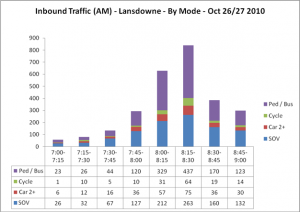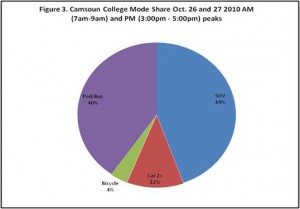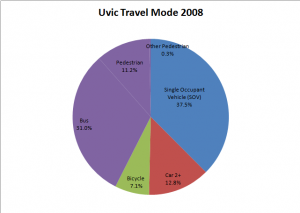Eager to see how their transportation demand management plan was actually working, Camosun recently embarked on a first-ever mode share count at both their campuses. Given that Oak Bay plays host to their Landsdowne Campus parking lots (Saanich gets the interesting bits like the buildings), I thought Iwould highlight a few preliminary results here. (It has nothing to do with the fact that I stood for several hours in the cold working on the count). Take a look:
for comparative reference, UVic’s 2008 modeshare:
The 2010 count data, which I was also involved in, isn’t available yet, so I had to use the 2008, from UVic Sustainability’s page. Both use the same method, with a few differences:
- UVic counts from 6am-9am and from 2pm-6pm, Camosun from 7am-9am and 3pm-5pm
- UVic uses BC Transit data for bus ridership exlusively, Camosun counted pedestrians and bus riders together and will separate out transit ridership with transit data later. How accurate this is, I don’t know as unlike boardings, disembarking passengers are not accurately counted due to the technology involved.
The data shows that Camosun has some work to do to catch up with UVic’s numbers, although given the suburban nature of Interurban, they are surprisingly close. One key barrier to greater cycling and walking was distance (in the 2009 Tod Litman-written [download id=”4″] (PDF, pg 19-20) in 2009. And this is only going to get worse when the various nursing and other health care programs move out to Interurban at some point in the near future. Nice to see the hard numbers though. Makes it easier to sell pedestrian, cycling, and transit improvements to possibly skeptical councils.



Great numbers – what is the trend here? Victoria really does seem to perform well in general. One nitpicky question: do the ‘pedestrian’ numbers also include people who are walking from their cars parked a block or two/three away?
Camosun’s trends are unknown as this is the first count, but if they follow UVic’s (see the UVic Sustainability page for past count info), then they are likely to be increasing in transit, down in SOV, and flat in everything else.
As for pedestrian, yes, they would include that. The counting works by establishing a “screen line” and counting everything that crosses that line. However, not a lot of people do that because the parking people in Oak Bay/Saanich crack down pretty hard (and unlike UVic, there is no non-residential parking nearby.)